
Pomona Island is the largest island within Lake Manapouri, in Fiordland National Park, in New Zealand's South Island. With an area of 262 hectares, it is the largest island to be found within any New Zealand lake.
Austroblechnum divergens, synonyms including Blechnum divergens, Blechnum rimbachii and Blechnum floresii, is a species of fern in the family Blechnaceae.

Cranfillia fluviatilis, synonym Blechnum fluviatile, is a fern known in the Māori language as kiwikiwi. A herbaceous plant, C. fluviatilis is a "hard fern" of the genus Cranfillia in the family Blechnaceae. It was identified by Patrick Brownsey in 1979. Other common names are star fern, creek fern, kawakawa and kiwakiwa.
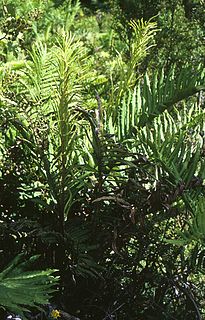
Parablechnum cordatum, the Chilean hard fern or costilla de vaca, is a fern of the family Blechnaceae, native to Chile. It is also found in neighboring areas of Argentina and the Juan Fernández Islands.
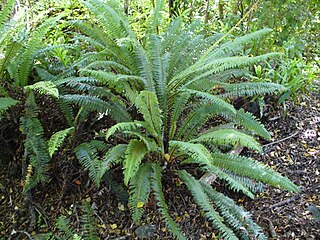
Lomaria discolor, synonym Blechnum discolor, commonly called crown fern, is a species of fern in the family Blechnaceae. This species is endemic to New Zealand. As noted by C. Michael Hogan, this species is found in a number of forest communities in diverse locations within New Zealand, and is sometimes a dominant understory component.

Zealandia pustulata, synonym Microsorum pustulatum, is a species of fern within the family Polypodiaceae.

Dendroconche scandens, synonym Microsorum scandens, commonly called fragrant fern, is a species of fern within the family Polypodiaceae. This species is native to parts of New Zealand and Australia, as well as some offshore islands. It has been introduced to South Africa and Zimbabwe. An example occurrence in New Zealand's North Island is in the Hamilton Ecological District where it is associated with a number of other ferns including Icarus filiforme and Lomaria discolor.
Austroblechnum leyboldtianum, synonym Blechnum blechnoides, known as iquide in Chilean Spanish, is a fern species endemic to Chile.

Austroblechnum lanceolatum, synonym Blechnum chambersii, is a species of fern within the family Blechnaceae, found in Australia, New Zealand, Samoa and Fiji.
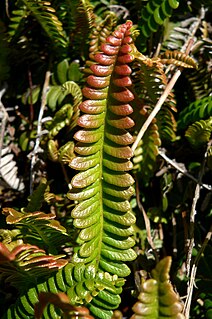
Austroblechnum penna-marina, synonym Blechnum penna-marina, known as Antarctic hard-fern, alpine water fern and pinque, is a species of fern in the family Blechnaceae, with a natural range from the Araucanía Region to the south and from the coast to the tree line of the Magellanic forests in Chile and adjacent areas of Argentina. It is also found in New Zealand, Australia and some Pacific islands. It is evergreen and grows to 20 cm (8 in).
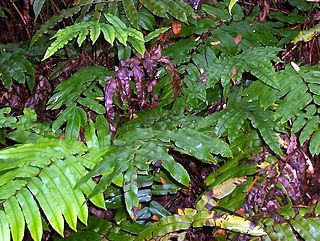
Parablechnum wattsii, synonym Blechnum wattsii, is a common terrestrial fern growing in rainforest and open forest. It is often seen near creeks in much of south eastern Australia, including Victoria, Tasmania, South Australia, New South Wales and Queensland. The specific epithet wattsii honours William Walter Watts (1856-1920). Watts was considered an authority on mosses and ferns and has more than 30 species named for him. Common names by which the species may be called are hard water fern - from its stiff leathery fronds, leech fern - as forest workers often encounter leaches while working in clusters of these ferns, hard hill fern - from the fern's habit and habitat, and red cabbage fern - from the bronze-pink colour of the young fronds resembling cooked red cabbage.

Lomaria nuda, commonly known as the fishbone waterfern, is a fern that grows up to a metre tall, and is abundant in rainforest and eucalyptus forests in eastern Australia. The species is placed in the genus Lomaria in the Pteridophyte Phylogeny Group classification of 2016, but is often retained in genus Blechnum as Blechnum nudum.

Austroblechnum patersonii, synonym Blechnum patersonii, is a fern in the family Blechnaceae. It is known as the strap water-fern.

Austroblechnum colensoi, synonym Blechnum colensoi, also known as Colenso's hard fern, waterfall fern or peretao is a species of fern native to New Zealand. It is distributed throughout the North, South and Stewart Islands.

Anchistea is a genus of leptosporangiate ferns in the family Blechnaceae. It has only one species, Anchistea virginica the Virginia chain fern, which has long creeping, scaly, underground stems or rhizomes giving rise to tall widely separated, deciduous, single leaves. In contrast, the leaves of Osmundastrum cinnamomeum, which can be mistaken for A. virginica, grow in a group from a crown. Also in contrast to O. cinnamomeum the leaves are monomorphic without distinct fertile fronds. The lower petiole or stipe is dark purple to black, shiny and swollen, the upper rachis is dull green. The leaf blade is green and lanceolate, composed of 12 to 23 paired, alternate pinnatifid pinnae. The pinnae are subdivided into 15 to 20 paired segments that are ovate to oblong. The lower rachis is naked for about half its length. The sori or spore-producing bodies are found on the underside of the pinnae and are long and form a double row which outlines the major veins of the pinnae. In common with all ferns, A. virginica exhibits a gametophyte stage in its life cycle and develops a haploid reproductive prothallus as an independent plant. The spores are produced in red-brown sori which line the spaces (areolae) between the costa and costules. Further photographs can be found at the Connecticut Botanical Society and Ontario Ferns websites.

Cranfillia fullagari, synonym Blechnum fullagarii, is a fern in the family Blechnaceae. The specific epithet honours James Fullagar, who collected plants on Lord Howe Island for the Royal Botanic Gardens, Melbourne.

Austroblechnum is a genus of ferns in the family Blechnaceae, subfamily Blechnoideae, according to the Pteridophyte Phylogeny Group classification of 2016. The genus is accepted in a 2016 classification of the family Blechnaceae, but other sources sink it into a very broadly defined Blechnum, equivalent to the whole of the PPG I subfamily.
Austroblechnum lehmannii is a species of fern in the family Blechnaceae. It is native to Mexico, Central America, South America and the Galápagos Islands.
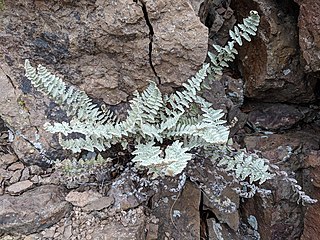
Myriopteris rufa, commonly known as Eaton's lip fern, is a moderately-sized fern of Mexico and the southwestern United States, with outlying populations in Costa Rica and the Appalachian Mountains. One of the cheilanthoid ferns, it was usually classified in the genus Cheilanthes, as Cheilanthes eatonii, until 2013, when the genus Myriopteris was again recognized as separate from Cheilanthes. It typically grows in rocky habitats, most frequently on limestone but also sometimes on basalt or shale.
















